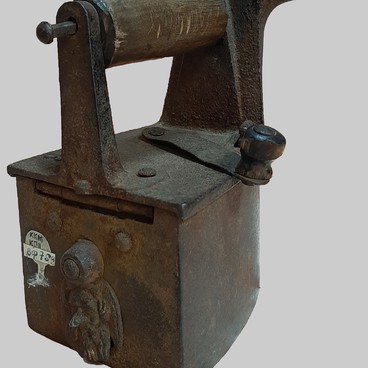Scissors from the museum’s collection were made at the end of the 19th century. There are two large identical rings on the handle. The blades are connected by a riveting attachment. The stamp “S. Sergiev v Pavlov” remained on the blade under the attachment. Unlike office scissors, these are more massive and longer. Their blades are made of special steel and are not sharpened at right angles. This sharpening made it possible to make incisions in the corners of the fabric exactly along the intended line, which was necessary, for example, when processing a slash pocket with a leaf. Office scissors with a straight angle of sharpening of blades are unsuitable for such work. For sewing masters, this device was irreplaceable. It helped to work with complex fabrics, perform cutting with high accuracy, and form a smooth straight cut.
The presented scissors were intended for a professional tailor. The word “portnoy” (“dressmaker”) itself is derived from the word “porty” (“pants”), which in Russia originally meant clothing in general. Only in the 16th century did the word “clothing” appear, thus replacing the old designation from everyday use. After that, all clothing was called “dress”, and porty began to mean only one element of men’s clothing. Over time, the tailor profession itself was divided into several specializations. There were specialists of a narrow profile, such as fur coat makers, mitten makers, and hat makers.
The word ‘scissors’ appeared at a time when people began to cut with two blades instead of one. That is why this word in many languages has only the plural form. The technology was as follows. They took two more or less identical knives that were not connected to each other. The lower knife was held with the left hand, and the upper knife was moved with the right hand. Then the pair of knives began to be connected together with a piece of cloth or rope.
Over time, the man connected both blades with a bracket. The most ancient scissors on the bracket were created three and a half thousand years ago in Ancient Rome and were intended only for shearing sheep. This design has remained unchanged for two thousand years. Scissors were made of steel and iron, covered with gilding, and richly decorated. More than a thousand years ago, scissors were improved. The blade began to connect with a nail.
The presented scissors were intended for a professional tailor. The word “portnoy” (“dressmaker”) itself is derived from the word “porty” (“pants”), which in Russia originally meant clothing in general. Only in the 16th century did the word “clothing” appear, thus replacing the old designation from everyday use. After that, all clothing was called “dress”, and porty began to mean only one element of men’s clothing. Over time, the tailor profession itself was divided into several specializations. There were specialists of a narrow profile, such as fur coat makers, mitten makers, and hat makers.
The word ‘scissors’ appeared at a time when people began to cut with two blades instead of one. That is why this word in many languages has only the plural form. The technology was as follows. They took two more or less identical knives that were not connected to each other. The lower knife was held with the left hand, and the upper knife was moved with the right hand. Then the pair of knives began to be connected together with a piece of cloth or rope.
Over time, the man connected both blades with a bracket. The most ancient scissors on the bracket were created three and a half thousand years ago in Ancient Rome and were intended only for shearing sheep. This design has remained unchanged for two thousand years. Scissors were made of steel and iron, covered with gilding, and richly decorated. More than a thousand years ago, scissors were improved. The blade began to connect with a nail.



